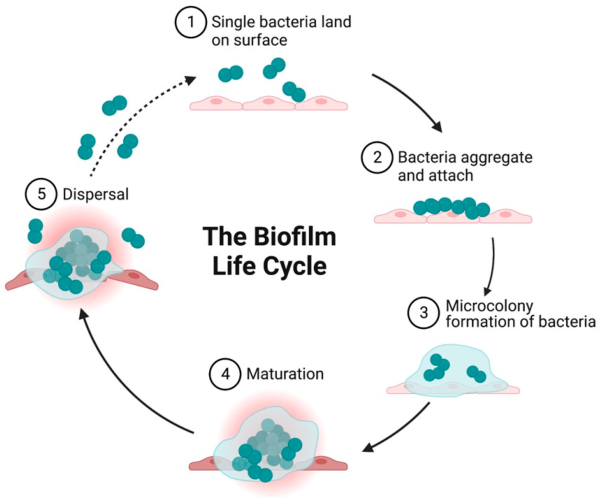Wepresentacontinuoustime/discrete space model of biofilm growth, starting from the semi-discrete master equation. The probabilities of biomass movement into neighboring sites depend on the local biomass density and on the biomass density in the target site such that spatial movement only takes place if (i) locally not enough space is available to accommodate newly produced biomass and (ii) the target site has capacity to accommodate new biomass. This mimics the rules employed by Cellular Automata models of biofilms. Grid refinement leads formally to a degenerate parabolic equation. We show that a set of transition rules can be found such that a previously studied ad hoc density-dependent diffusion-reaction model of biofilm formation is approximated well.
By: Dr Hassan Khassehkhan

This study introduces a novel mathematical model for simulating the growth of biofilms-complex communities of bacteria that form on surfaces. Instead of using purely stochastic cellular automata or traditional continuous models, the authors present a hybrid framework that bridges both approaches. The model is constructed using a spatially discrete, time-continuous master equation, which represents how bacterial biomass spreads across a grid of sites based on local space availability and population pressure.
The model captures two critical behaviors observed in real biofilms:
Limited space for growth-biomass only spreads to neighboring areas when there’s no room left locally.
Volume filling effect-biomass prefers to stay in place unless the local site is overcrowded and the adjacent sites can accommodate more biomass.
These dynamics mimic those used in cellular automata-based simulations but translate them into a more mathematically structured and analyzable framework. As the grid resolution increases, the discrete model converges to a continuous nonlinear diffusion-reaction equation, previously used in biofilm modeling, but here derived systematically rather than introduced arbitrarily.
The derived continuous equation includes a density-dependent diffusion coefficient. This coefficient accounts for both degenerate diffusion (which limits biomass movement when density is low) and fast diffusion (which accelerates movement when the local density is near maximum). These two opposing effects replicate the realistic expansion behavior of biofilms as they grow and encounter spatial constraints.
The authors also address an inverse problem: determining how to define the probabilistic rules of movement (in the discrete model) so that the continuous equation they generate matches a known form with a specific nonlinear diffusion term. They do this by proposing approximations that preserve mathematical and biological consistency, showing that even if an exact match is impossible due to inherent constraints, a very close approximation is achievable.
To validate the model, the authors run 2D computer simulations. These simulations start with initial bacterial colonies and track their spread over time. The model successfully reproduces the typical growth dynamics observed in biofilms-initial accumulation, local saturation, and eventual expansion and merging of colonies. They also conduct grid refinement studies, showing that the solution becomes more stable and convergent with higher resolution, confirming the numerical robustness of their method.
Finally, the paper concludes by emphasizing the value of the master equation approach as a bridge between discrete stochastic models (like cellular automata) and continuous deterministic models (like partial differential equations). This bridge not only improves theoretical understanding but also supports more flexible and computationally efficient simulations. Future extensions of the work could include modeling multi-species biofilms or accounting for directional growth preferences and nutrient limitations.
 | A Nonlinear Master Equation for a Degenerate Diffusion Model of Biofilm Growth |

